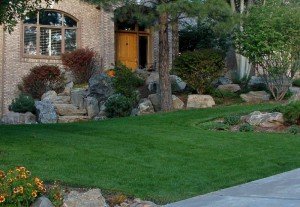 What Americans think they know – and really don’t know – about lawn care might surprise you.
What Americans think they know – and really don’t know – about lawn care might surprise you.
Up to 64% of Americans who have a landscape believe faulty information about lawn care. And since about 81% of us do most of the work ourselves, the majority of our lawns are probably getting less than optimal attention. It’s no wonder that 7 in 10 Americans admit their lawn could use improvement.*
April is National Lawn Care Month, so now is a good time to debunk some of our common lawn care myths. Test your own long-held beliefs against the following myths and facts.
Myth or fact? The best time to fertilize a lawn is in early spring.
Myth. According to researchers at Colorado State University, in most cases the common fertilizers promoted in early spring are best applied later on. Holding off ’til about May gives the grass roots time to develop without having to support emerging top growth. The best way to have a green lawn in the spring is to fertilize in late fall, around Halloween.
Myth or fact? Sprinkler systems can save more water than using a garden hose.
Fact. A well-designed sprinkler system that includes water-conserving nozzles, drip irrigation, sensors and a smart controller can offer cost savings of 15-20% on water bills. Watering deeply and less frequently and in the morning adds to the efficiency.
Factor in rebates from local water providers and the ROI adds up even faster.
Myth or fact? A brown lawn is a dead lawn.
Myth. Kentucky bluegrass – the most common lawn found in Colorado – will shut down and go dormant during times of high temperatures and scarce water in the middle of the summer. While dormant, the grass may be brown, but this is the lawn’s survival mode.
When temperatures cool and there is sufficient water, the lawn will return to its normal green color. Bluegrass is more resilient than we give it credit for being.
Myth or fact? Mowing the lawn short for a trim, neat appearance is good for it.
Myth. Cutting the lawn longer, to a height of about 3 inches, promotes health. This allows the lawn to shade itself which helps it hold in moisture and stay cooler. Plus, the lawn will do a better job resisting weeds and have a deeper color.
Also try to avoid cutting off any more than 1/3 of the grass length at one time. This may require more frequent than weekly mowing when the turf is in fast-growth mode.
Myth or fact? Leaving clippings on top of the lawn after mowing is good for the lawn.
Fact. Grass clippings are mostly water and decompose rapidly which creates a significant amount of fertilizer for the lawn. Research shows up to 1/3 of fertilizer applications can be reduced by simply “grass cycling” clippings onto the lawn.
Myth or fact? To save water, we should eliminate lawns.
Myth. California’s recent “cash for grass” campaign seemed like a logical solution to severe drought. And while some lawns may be larger than needed or improperly placed on the property, properly designed turf areas provide usable space and important environmental benefits such as earth worms, soil microbes and fungi that contribute to the urban ecosystem. Plus, they help cool the urban environment. When properly designed, installed and maintained, lawns do contribute value to the landscape.
*Data courtesy National Association of Lawncare Professionals which conducted a Harris Poll in February 2016.
